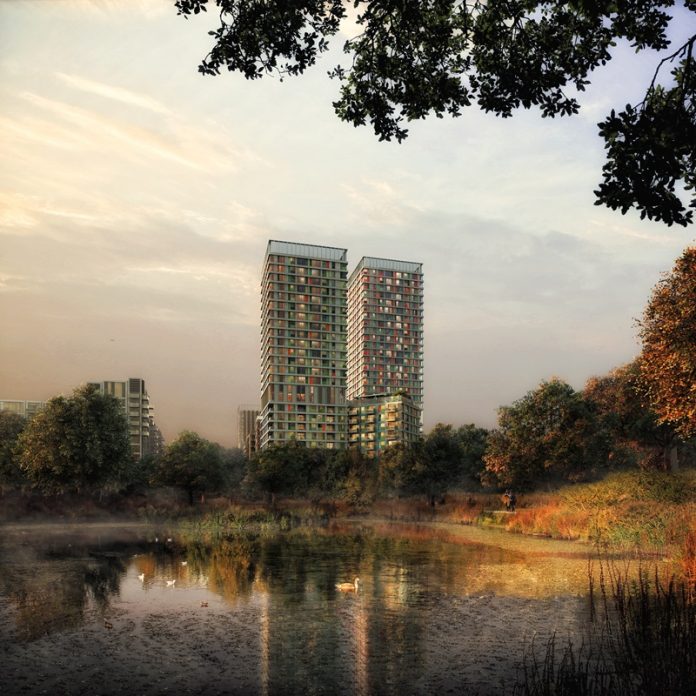Mace Tech’s High Rise Solutions combines BIM and digital technology with an on-site, self-contained factory approach to reduce construction times while improving quality
A “next generation” construction method that combines digital BIM technology with a new offsite manufacturing approach to construct buildings faster, safer and to a consistently higher quality has been launched at the redevelopment of the former London 2012 Athletes’ Village in Stratford.
Mace Tech, a new business unit of global consultancy and construction firm Mace that will head up the deployment and delivery of advanced offsite sub-assembly construction methods, said the system, High Rise Solutions (HRS), is an evolution of the thinking behind the award-winning Jump Factory – a self-contained factory build around the perimeter of a new development that uses efficient material handling and just-in-time delivery of prefabricated elements to construct buildings floor-by-floor.
The Jump Factory approach allowed Mace Tech to reduce design and construction programmes by 25%, vehicle movements by 40% and waste by 70%.
Following the success of the Jump Factory, Mace worked with Australian firm Hickory to adapt the building system for construction in the UK. Using parametric modelling tools and artificial intelligence, HRS is able to draw from a catalogue of components to design and manufacture the structure and façade subassemblies offsite.
NO6 East Village
Following a pilot of HRS at a major London construction project, the system is now being used to construct NO6, a build-to-rent scheme in the East Village, the former London 2012 Athletes’ Village being built by Mace on behalf of Get Living. Split across two towers of 26 and 31 storeys, the development will deliver 524 new homes.
Mace is converting site activities to an assembly process by installing modules concurrently with bathroom pods, utility cupboards and MEP service modules to drastically reduce programme times and improve productivity up to six times compared with current industry performance.
Prior to construction, all of the modularised units are put into BIM 360 modelling, which allows every component to be tracked from its design to manufacture, despatch, delivery to site and installation.
The HRS approach will help to shorten the construction programme by 18 weeks, with 20% fewer workers onsite compared with a traditional building approach.
Mark Reynolds, chief executive of Mace, said: “The launch of Mace Tech marks an important milestone, not only for Mace but for the industry. Unless we radically rethink how we build, we will never be able to deliver the housing and infrastructure that is desperately needed across the UK while reducing our carbon footprint.
“Availability of smart data is essential to radically change our industry. Mace Tech will allow us to harness the latest digital technologies and offsite construction methods to create better buildings. HRS is already helping to deliver housing faster with less waste and reduce carbon emissions.”
Shaun Tate, business unit director at Mace Tech, added: “HRS is more than just a new offsite construction method – it is a new digital approach to how we approach to how we assemble and construct buildings.
“We interrogated the entire production to deliver cycle, taking inspiration from the auto industry with its integrated production and assembly line, looking at how we can develop smarter and more efficient offsite assembly methods to drive better outcomes.
“At N06, we can already see the benefits that this method is delivering with just-in-time delivery and much more streamlined work processes.
“As part of Mace’s approach to strategic investment in new construction methods, Mace Tech has been established as a vehicle to launch new subassembly and offsite methods to the market, including HRS.”
Shaun Tate
Director
Mace Tech
Twitter: @MaceGroup
LinkedIn: Mace Group
Youtube: Mace Group
Instagram: @macegroup














